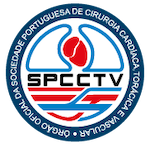Ventricular Septal Rupture After Acute Myocardial Infarction – Can Va-Ecmo Give Us Extra Time?
DOI:
https://doi.org/10.48729/pjctvs.416Keywords:
Ventricular septal rupture, myocardial infarction, mechanical circulatory supportAbstract
Ventricular septal rupture (VSR) after myocardial infarction (MI) is a rare but life-threatening complication. Although surgery is the gold standard treatment, best surgical timing is still a matter of debate. Studies are showing a tendency towards survival improvement with delayed intervention on the assumption that scarring of the infarcted tissue may facilitate patch suturing and avoid relapse of the defect. Mechanical circulatory support (MCS) may be useful, not only for hemodynamic stabilisation and optimization before surgery, but also as a bridge to decide best surgical timing. Allowing myocardial recovery into a resistant scar, recurrence of VSR may be reduced and promotes a longer-lasting surgical repair. The aim of this case report is to share the outcomes and management of two MI-associated VSR patients submitted to delayed surgery after VA-ECMO stabilisation. Although VSR repair failed, VA-ECMO allowed the patient's stabilisation, time for decision and became a bridge for successful heart transplant.Downloads
References
Zbikowska K, Wróbel K. Mechanical Circulatory Support in Delayed Surgery of Post-Infarction Ventricular Septal Rupture in Patients in Cardiogenic Shock - A Review. JCM. 2022 Aug 12;11(16):4728.
Ronco D, Matteucci M, Ravaux JM, Marra S, Torchio F, Corazzari C, et al. Mechanical Circulatory Support as a Bridge to Definitive Treatment in Post-Infarction Ventricular Septal Rupture. JACC: Cardiovascular Interventions. 2021 May;14(10):1053–66.
O’Gara PT, Kushner FG, Ascheim DD, Casey DE, Chung MK, De Lemos JA, et al. 2013 ACCF/AHA Guideline for the Management of ST-Elevation Myocardial Infarction: Executive Summary. Journal of the American College of Cardiology. 2013 Jan;61(4):485–510.
Shibasaki I, Otani N, Saito S, Ogawa H, Masawa T, Tsuchiya G, et al. Overview of mechanical circulatory support for the management of post-myocardial infarction ventricular septal rupture. Journal of Cardiology. 2023 May;81(5):491–7.
Schlotter F, Huber K, Hassager C, Halvorsen S, Vrancks P, Pöss J, et al. Ventricular septal defect complicating acute myocardial infarction: diagnosis and management. A Clinical Consensus Statement of the Association for Acute CardioVascular Care (ACVC) of the ESC, the European Association of Percutaneous Cardiovascular Interventions (EAPC) of the ESC and the ESC Working Group on Cardiovascular Surgery. European Heart Journal. 21 de julho de 2024;45(28):2478–92.
Ibanez B, James S, Agewall S, Antunes MJ, Bucciarelli-Ducci C, Bueno H, et al. 2017 ESC Guidelines for the management of acute myocardial infarction in patients presenting with ST-Segment elevation. European Heart Journal. 2018 Jan 7;39(2):119–77.
Arnaoutakis GJ, Zhao Y, George TJ, Sciortino CM, McCarthy PM, Conte JV. Surgical Repair of Ventricular Septal Defect After Myocardial Infarction: Outcomes From The Society of Thoracic Surgeons National Database. The Annals of Thoracic Surgery. 2012 Aug;94(2):436–44.
Morimura H, Tabata M. Delayed surgery after mechanical circulatory support for ventricular septal rupture with cardiogenic shock. Interactive CardioVascular and Thoracic Surgery. 2020 Dec 7;31(6):868–73.
Downloads
Published
How to Cite
License
Copyright (c) 2025 Portuguese Journal of Cardiac Thoracic and Vascular Surgery

This work is licensed under a Creative Commons Attribution 4.0 International License.





